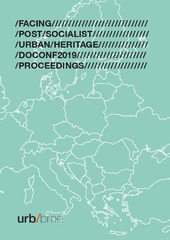Common Areas in Multi-family Housing in Serbia: Case Study of Cerak Vinogradi, Belgrade
Апстракт
Multi-family housing as opposed to individual housing is recognized as a model for solving multiple problems as an intensification of social changes and changes in the demographic picture of the population and increase in the number of inhabitants in cities. Need to change and adapt is one of the key determinants of modern life in the city. However, the special focus of this paper is on common areas as collective spaces of the multi-family housing. The research examines the use of common areas by guidelines/propositions for overall housing design given by Milenković: the examination of hierarchy, the relationship between the individual and the collective sphere, the need for the built space to provide an active relationship of planned and spontaneous. Paper researches case study of Cerak Vinogradi housing complex as one of the recently protected sites and only protected site in its entirety form the second part of the 20th century. The paper shows that the proper common areas can le...d to multifunctional spaces for activities and it can be a more sustainable and livable space.
Кључне речи:
Multi-family housing / 20th century / common area / Belgrade / Cerak VinogradiИзвор:
Facing post socialist urban heritage - Doconf2019, 2019, 42-45Издавач:
- Budapest : Department of Urban Planning and Design, Faculty of Architecture Budapest University of Technology and Economics (BME)
Финансирање / пројекти:
- Просторни, еколошки, енергетски и друштвени аспекти развоја насеља и климатске промене - међусобни утицаји (RS-MESTD-Technological Development (TD or TR)-36035)
Напомена:
- Editor: Melinda BENKŐ
Група
RAUmPlanTY - CONF AU - Brankov, Borjan PY - 2019 UR - http://www.urbanisztika.bme.hu/doconf2019/ UR - https://raumplan.iaus.ac.rs/handle/123456789/534 AB - Multi-family housing as opposed to individual housing is recognized as a model for solving multiple problems as an intensification of social changes and changes in the demographic picture of the population and increase in the number of inhabitants in cities. Need to change and adapt is one of the key determinants of modern life in the city. However, the special focus of this paper is on common areas as collective spaces of the multi-family housing. The research examines the use of common areas by guidelines/propositions for overall housing design given by Milenković: the examination of hierarchy, the relationship between the individual and the collective sphere, the need for the built space to provide an active relationship of planned and spontaneous. Paper researches case study of Cerak Vinogradi housing complex as one of the recently protected sites and only protected site in its entirety form the second part of the 20th century. The paper shows that the proper common areas can led to multifunctional spaces for activities and it can be a more sustainable and livable space. PB - Budapest : Department of Urban Planning and Design, Faculty of Architecture Budapest University of Technology and Economics (BME) C3 - Facing post socialist urban heritage - Doconf2019 T1 - Common Areas in Multi-family Housing in Serbia: Case Study of Cerak Vinogradi, Belgrade SP - 42 EP - 45 UR - https://hdl.handle.net/21.15107/rcub_raumplan_534 ER -
@conference{
author = "Brankov, Borjan",
year = "2019",
abstract = "Multi-family housing as opposed to individual housing is recognized as a model for solving multiple problems as an intensification of social changes and changes in the demographic picture of the population and increase in the number of inhabitants in cities. Need to change and adapt is one of the key determinants of modern life in the city. However, the special focus of this paper is on common areas as collective spaces of the multi-family housing. The research examines the use of common areas by guidelines/propositions for overall housing design given by Milenković: the examination of hierarchy, the relationship between the individual and the collective sphere, the need for the built space to provide an active relationship of planned and spontaneous. Paper researches case study of Cerak Vinogradi housing complex as one of the recently protected sites and only protected site in its entirety form the second part of the 20th century. The paper shows that the proper common areas can led to multifunctional spaces for activities and it can be a more sustainable and livable space.",
publisher = "Budapest : Department of Urban Planning and Design, Faculty of Architecture Budapest University of Technology and Economics (BME)",
journal = "Facing post socialist urban heritage - Doconf2019",
title = "Common Areas in Multi-family Housing in Serbia: Case Study of Cerak Vinogradi, Belgrade",
pages = "42-45",
url = "https://hdl.handle.net/21.15107/rcub_raumplan_534"
}
Brankov, B.. (2019). Common Areas in Multi-family Housing in Serbia: Case Study of Cerak Vinogradi, Belgrade. in Facing post socialist urban heritage - Doconf2019 Budapest : Department of Urban Planning and Design, Faculty of Architecture Budapest University of Technology and Economics (BME)., 42-45. https://hdl.handle.net/21.15107/rcub_raumplan_534
Brankov B. Common Areas in Multi-family Housing in Serbia: Case Study of Cerak Vinogradi, Belgrade. in Facing post socialist urban heritage - Doconf2019. 2019;:42-45. https://hdl.handle.net/21.15107/rcub_raumplan_534 .
Brankov, Borjan, "Common Areas in Multi-family Housing in Serbia: Case Study of Cerak Vinogradi, Belgrade" in Facing post socialist urban heritage - Doconf2019 (2019):42-45, https://hdl.handle.net/21.15107/rcub_raumplan_534 .



